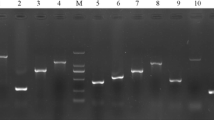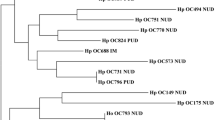Abstract
Helicobacter pylori cagPAI genes play an important role in pathogenesis, however little is known about their functions in isolates from Turkish patients. We aimed to evaluate the intactness and the effect of the cagPAI genes (cagT, cagM, cagE, cagA) and cagA EPIYA motifs on the AGS morphological changes and IL-8 induction. Of 53 patients 38 were found infected with H. pylori. PCR amplification of the cagPAI genes showed 42.1 % intact, 39.5 % partially deleted and 18.4 % with complete deletions. Isolates from gastritis, duodenal and gastric ulcer patients with intact and partially deleted cagPAI genes induced higher IL-8 secretion than those with complete deletions. Isolates from gastritis patients had higher deletion frequencies of the cagT and cagM genes than the other two genes. Infection of AGS cells with isolates that possess intact cagPAI and EPIYA-ABC resulted in the formation of the hummingbird phenotype. The cagA positive isolates induced higher IL-8 secretion than cagA negative isolates. Isolates from DU patients with more than one EPIYA-C motif induced higher concentrations of IL-8 than those with EPIYA-ABC. In conclusion, the intactness of the cagPAI in our isolates from different patients was not conserved. An intact cagPAI was found to play an important role in the pathogenesis of DU but not GU or gastritis. The cagA gene, but not other cagPAI genes, was associated with the induction of IL-8 and the morphological changes of the AGS cells. An increase in the number of EPIYA-C motifs had noticeable effect on the formation of the hummingbird phenotype.



Similar content being viewed by others
References
Alfizah H, Ramelah M (2012) Variant of Helicobacter pylori CagA proteins induce different magnitude of morphological changes in gastric epithelial cells. Malays J Pathol 34:29–34
Argent RH, Zhang Y, Atherton JC (2005) Simple method for determination of the number of Helicobacter pylori CagA variable-region EPIYA tyrosine phosphorylation motifs by PCR. J Clin Microbiol 43:791–795
Atherton JC, Blaser MJ (2009) Coadaptation of Helicobacter pylori and humans: ancient history, modern implications. J Clin Invest 119:2475–2487
Backert S, Schwarz T, Miehlke S, Kirsch C, Sommer C, Kwok T, Gerhard M, Goebel UB, Lehn N, Koenig W, Meyer TF (2004) Functional analysis of the cag pathogenicity island in Helicobacter pylori isolates from patients with gastritis, peptic ulcer, and gastric cancer. Infect Immun 72:1043–1056
Baghaei K, Shokrzadeh L, Jafari F, Dabiri H, Yamaoka Y, Bolfion M, Zojaji H, Aslani MM, Zali MR (2009) Determination of Helicobacter pylori virulence by analysis of the cag pathogenicity island isolated from Iranian patients. Dig Liver Dis 41:634–638
Bourzac KM, Botham CM, Guillemin K (2007) Helicobacter pylori CagA induces AGS cell elongation through a cell retraction defect that is independent of Cdc42, Rac1, and Arp2/3. Infect Immun 75:1203–1213
Brandt S, Kwok T, Hartig R, Konig W, Backert S (2005) NF-κB activation and potentiation of proinflammatory responses by the Helicobacter pylori CagA protein. Proc Natl Acad Sci USA 102:9300–9305
Cendron L, Couturier M, Angelini A, Barison N, Stein M, Zanotti G (2009) The Helicobacter pylori CagD (HP0545, Cag24) protein is essential for CagA translocation and maximal induction of interleukin-8 secretion. J Mol Biol 386:204–217
Censini S, Lange C, Xiang Z, Crabtree JE, Ghiara P, Borodovsky M, Rappuoli R, Covacci A (1996) cag, a pathogenicity island of Helicobacter pylori, encodes type I-specific and disease-associated virulence factors. Proc Natl Acad Sci USA 93:14648–14653
Eaton KA, Kersulyte D, Mefford M, Danon SJ, Krakowka S, Berg DE (2001) Role of Helicobacter pylori cag region genes in colonization and gastritis in two animal models. Infect Immun 69:2902–2908
El-Etr SH, Mueller A, Tompkins LS, Falkow S, Merrell DS (2004) Phosphorylation-independent effects of CagA during interaction between Helicobacter pylori and T84 polarized monolayers. J Infect Dis 190:1516–1523
Fischer W, Puls J, Buhrdorf R, Gebert B, Odenbreit S, Haas R (2001) Systematic mutagenesis of the Helicobacter pylori cag pathogenicity island: essential genes for CagA translocation in host cells and induction of interleukin-8. Mol Microbiol 42:1337–1348
Guillemin K, Salama NR, Tompkins LS, Falkow S (2002) Cag pathogenicity island-specific responses of gastric epithelial cells to Helicobacter pylori infection. Proc Natl Acad Sci USA 99:15136–15141
Ishikawa S, Ohta T, Hatakeyama M (2009) Stability of Helicobacter pylori CagA oncoprotein in human gastric epithelial cells. FEBS Lett 583:2414–2418
Jafari F, Shokrzadeh L, Dabiri H, Baghaei K, Yamaoka Y, Zojaji H, Haghazali M, Molaei M, Zali MR (2008) vacA genotypes of Helicobacter pylori in relation to cagA status and clinical outcomes in Iranian populations. Jpn J Infect Dis 61:290–293
Jones KR, Joo YM, Jang S, Yoo YJ, Lee HS, Chung IS, Olsen CH, Whitmire JM, Merrell DS, Cha JH (2009) Polymorphism in the CagA EPIYA motif impacts development of gastric cancer. J Clin Microbiol 47:959–968
Kauser F, Khan AA, Hussain MA, Carroll IM, Ahmad N, Tiwari S, Shouche Y, Das B, Alam M, Ali SM, Habibullah CM, Sierra R, Megraud F, Sechi LA, Ahmed N (2004) The cag pathogenicity island of Helicobacter pylori is disrupted in the majority of patient isolates from different human populations. J Clin Microbiol 42:5302–5308
Kawamura O, Murakami M, Araki O, Yamada T, Tomizawa S, Shimoyama Y, Minashi K, Maeda M, Kusano M, Mori M (2003) Relationship between gastric disease and deletion of cag pathogenicity island genes of Helicobacter pylori in gastric juice. Dig Dis Sci 48:47–53
Kidd M, Lastovica AJ, Atherton JC, Louw JA (2001) Conservation of the cag pathogenicity island is associated with vacA alleles and gastroduodenal disease in South African Helicobacter pylori isolates. Gut 49:11–17
Kim SY, Lee YC, Kim HK, Blaser MJ (2006) Helicobacter pylori CagA transfection of gastric epithelial cells induces interleukin-8. Cell Microbiol 8:97–106
Kumar S, Kumar A, Dixit VK (2010) Diversity in the cag pathogenicity island of Helicobacter pylori isolates in populations from North and South India. J Med Microbiol 59:32–40
Lage AP, Godfroid E, Fauconnier A, Burette A, Butzler JP, Bollen A, Glupczynski Y (1995) Diagnosis of Helicobacter pylori infection by PCR: comparison with other invasive techniques and detection of cagA gene in gastric biopsy specimens. J Clin Microbiol 33:2752–2756
Lai CH, Wang HJ, Chang YC, Hsieh WC, Lin HJ, Tang CH, Sheu JJ, Lin CJ, Yang MS, Tseng SF, Wang WC (2011) Helicobacter pylori CagA-mediated IL-8 induction in gastric epithelial cells is cholesterol-dependent and requires the C-terminal tyrosine phosphorylation-containing domain. FEMS Microbiol Lett 323:155–163
Lima VP, de Lima MA, Ferreira MV, Barros MA, Rabenhorst SH (2010) The relationship between Helicobacter pylori genes cagE and virB11 and gastric cancer. Int J Infect Dis 14:613–617
Lima VP, Silva-Fernandes IJ, Alves MK, Rabenhorst SH (2011) Prevalence of Helicobacter pylori genotypes (vacA, cagA, cagE and virB11) in gastric cancer in Brazilian’s patients: an association with histopathological parameters. Cancer Epidemiol 35:32–37
Maeda S, Yoshida H, Ikenoue T, Ogura K, Kanai F, Kato N, Shiratori Y, Omata M (1999) Structure of cag pathogenicity island in Japanese Helicobacter pylori isolates. Gut 44:336–341
Matteo MJ, Granados G, Pérez CV, Olmos M, Sanchez C, Catalano M (2007) Helicobacter pylori cag pathogenicity island genotype diversity within the gastric niche of a single host. J Med Microbiol 56:664–669
Mizushima T, Sugiyama T, Kobayashi T, Komatsu Y, Ishizuka J, Kato M, Asaka M (2002) Decreased adherence of cagG-deleted Helicobacter pylori to gastric epithelial cells in Japanese clinical isolates. Helicobacter 7:22–29
Nguyen LT, Uchida T, Tsukamoto Y, Trinh TD, Ta L, Mai HB, Le HS, Ho DQ, Hoang HH, Matsuhisa T, Okimoto T, Kodama M, Murakami K, Fujioka T, Yamaoka Y, Moriyama M (2010) Clinical relevance of cagPAI intactness in Helicobacter pylori isolates from Vietnam. Eur J Clin Microbiol Infect Dis 29:651–660
Nilsson C, Sillén A, Eriksson L, Strand ML, Enroth H, Normark S, Falk P, Engstrand L (2003) Correlation between cag pathogenicity island composition and Helicobacter pylori-associated gastroduodenal disease. Infect Immun 71:6573–6581
Olbermann P, Josenhans C, Moodley Y, Uhr M, Stamer C, Vauterin M, Suerbaum S, Achtman M, Linz B (2010) A global overview of the genetic and functional diversity in the Helicobacter pylori cag pathogenicity island. PLoS Genet 6(8):e1001069
Pacheco AR, Proença-Módena JL, Sales AI, Fukuhara Y, da Silveira WD, Pimenta-Módena JL, de Oliveira RB, Brocchi M (2008) Involvement of the Helicobacter pylori plasticity region and cag pathogenicity island genes in the development of gastroduodenal diseases. Eur J Clin Microbiol Infect Dis 27:1053–1059
Patra R, Chattopadhyay S, De R, Datta S, Chowdhury A, Ramamurthy T, Nair GB, Berg DE, Mukhopadhyay AK (2010) Intact cag pathogenicity island of Helicobacter pylori without disease association in Kolkata, India. Int J Med Microbiol 301:293–302
Peters TM, Owen RJ, Slater E, Varea R, Teare EL, Saverymuttu S (2001) Genetic diversity in the Helicobacter pylori cag pathogenicity island and effect on expression of anti-CagA serum antibody in UK patients with dyspepsia. J Clin Pathol 54:219–223
Quiroga AJ, Huertas A, Cómbita AL, Bravo MM (2010) Variation in the number of EPIYA-C repeats in CagA protein from Colombian Helicobacter pylori strains and its ability middle to induce hummingbird phenotype in gastric epithelial cells. Biomedica 30:251–258
Reyes-Leon A, Atherton JC, Argent RH, Puente JL, Torres J (2007) Heterogeneity in the activity of Mexican Helicobacter pylori strains in gastric epithelial cells and its association with diversity in the cagA gene. Infect Immun 75:3445–3454
Ritter B, Kilian P, Reboll MR, Resch K, DiStefano JK, Frank R, Beil W, Nourbakhsh M (2011) Differential effects of multiplicity of infection on Helicobacter pylori-induced signaling pathways and interleukin-8 gene transcription. J Clin Immunol 31:60–68
Salih BA, Bolek BK, Arikan S (2010) DNA sequence analysis of cagA 3′ motifs of Helicobacter pylori strains from patients with peptic ulcer diseases. J Med Microbiol 59:144–148
Schmidt HM, Andres S, Nilsson C, Kovach Z, Kaakoush NO, Engstrand L, Goh KL, Fock KM, Forman D, Mitchell H (2010) The cag PAI is intact and functional but HP0521 varies significantly in Helicobacter pylori isolates from Malaysia and Singapore. Eur J Clin Microbiol Infect Dis 29:439–451
Selbach M, Moese S, Meyer TF, Backert S (2002) Functional analysis of the Helicobacter pylori cag pathogenicity island reveals both VirD4-CagA-dependent and VirD4-CagA-independent mechanisms. Infect Immun 70:665–671
Sgouras DN, Panayotopoulou EG, Papadakos K, Martinez-Gonzalez B, Roumbani A, Panayiotou J, van Vliet-Constantinidou C, Mentis AF, Roma-Giannikou E (2009) cagA and vacA polymorphisms do not correlate with severity of histopathological lesions in Helicobacter pylori-infected Greek children. J Clin Microbiol 47:2426–2434
Yamahashi Y, Hatakeyama M (2013) PAR1b takes the stage in the morphogenetic and motogenetic activity of Helicobacter pylori CagA oncoprotein. Cell Adhes Migr 7:11–18
Zaidi SF, Ahmed K, Yamamoto T, Kondo T, Usmanghani K, Kadowaki M, Sugiyama T (2009) Effect of resveratrol on Helicobacter pylori-induced interleukin-8 secretion, reactive oxygen species generation and morphological changes in human gastric epithelial cells. Biol Pharm Bull 32:1931–1935
Acknowledgments
This study was supported by the grants of Fatih University (No: P50030903_2) and of the Scientific and Technological Research Council of Turkey (TÜBİTAK) (No: 111T370).
Conflict of interest
The authors declare that they have no conflict of interest.
Author information
Authors and Affiliations
Corresponding author
Rights and permissions
About this article
Cite this article
Salih, B.A., Guner, A., Karademir, A. et al. Evaluation of the effect of cagPAI genes of Helicobacter pylori on AGS epithelial cell morphology and IL-8 secretion. Antonie van Leeuwenhoek 105, 179–189 (2014). https://doi.org/10.1007/s10482-013-0064-5
Received:
Accepted:
Published:
Issue Date:
DOI: https://doi.org/10.1007/s10482-013-0064-5




